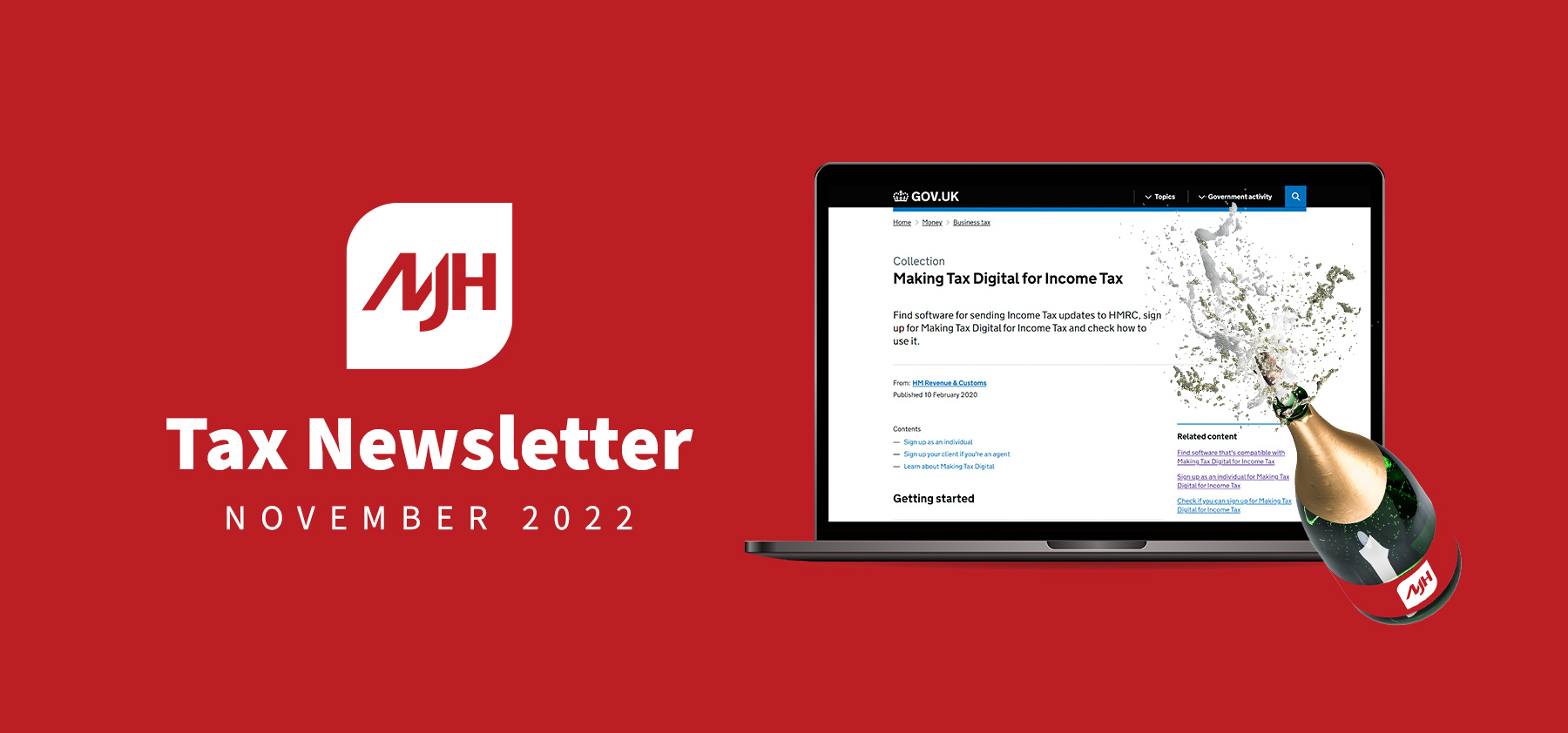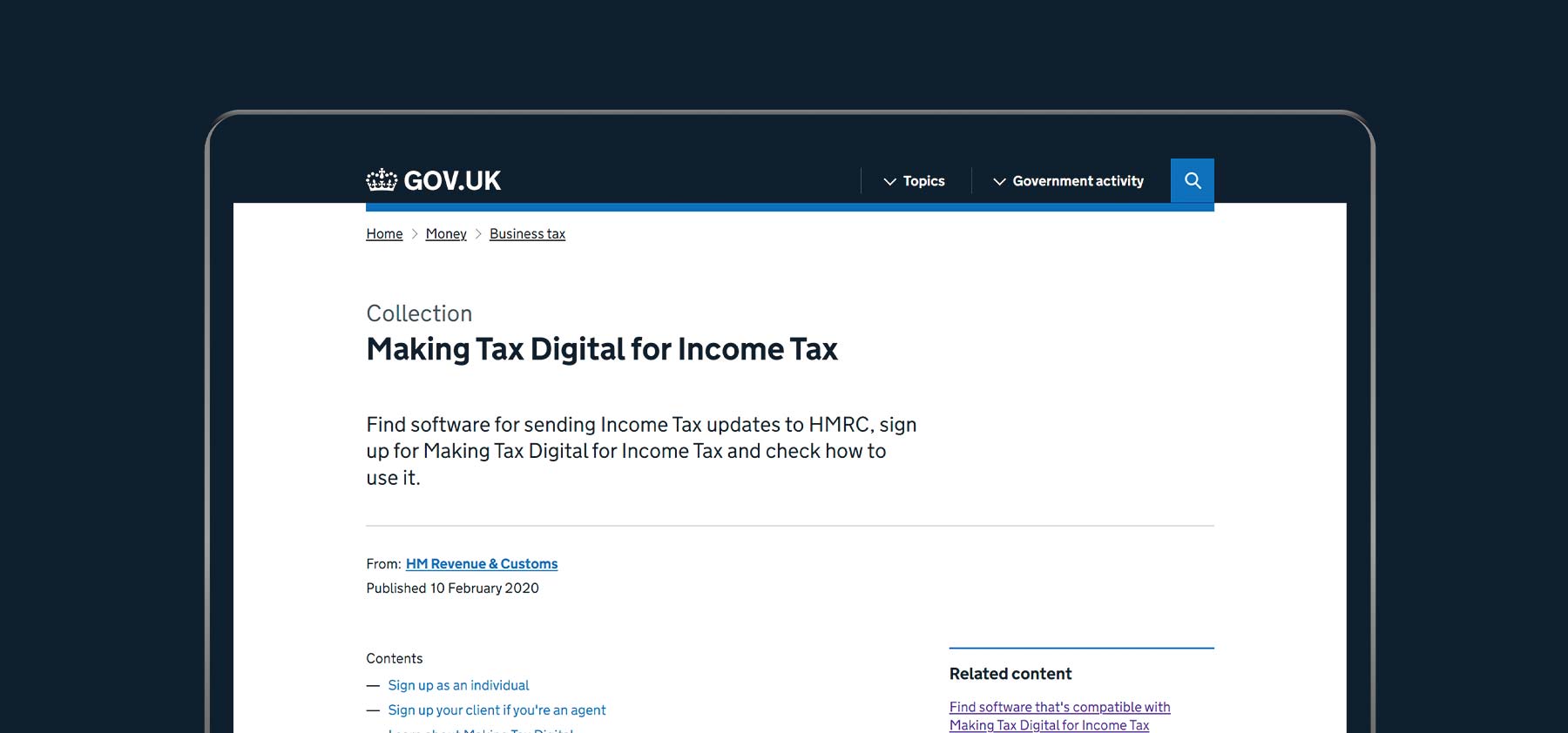
Latest news round-up
Making Tax Digital – should your business change its year-end now?
Making Tax Digital for Income Tax (MTD ITSA) is due to start on 6 April 2024 with the first year being 2024/25. In preparation, the rules that determine which profits of a non-company business are charged to tax for a particular tax year are also being reformed.
Which businesses will be affected?
It is important to note that not all unincorporated businesses will be affected. Basis period reform will only affect those businesses that do not have a 31 March – 5 April accounting year-end. Though MTD ITSA does not include partnerships initially, basis period reform affects all unincorporated clients without 31 March – 5 April year ends, sole traders, and partnerships alike.
What is changing?
The existing rules, which tax profits of an unincorporated business on a current year basis, are being abolished. Instead, profits will be taxed on a tax year basis. Therefore a tax return will show results for the tax year (6 April to 5 April) whatever the actual accounting date. An accounting date anywhere between 31 March and 5 April will be treated as being coterminous with a tax year.

Transition from one method to another
The 2023/24 tax year will be a transitional year to enable the change. For this year only, all businesses will be required to complete a tax return showing results for a period from the end of the basis period in 2022/23 to 5 April 2024. This change means that any business that does not prepare accounts on a tax year basis (6 April to 5 April) will declare and be taxed on profits of more than 12 months. The practicalities are that where the accounting date falls early in the tax year, the number of additional months to bring into account will be more than where the accounting date is later in the tax year.
For example, where a business prepares its accounts to 30 June each year, for 2023/24, the basis period will run from 1 July 2022 to 5 April 2024, i.e. 21 months. The tax bill will be based on results from the year to 30 June 2022 plus 9/12 of results from the year to 30 June 2024. Businesses with an accounting date of 30 April will potentially be worse hit reporting nearly two years’ profits on one tax return for 2023/24. The basis period will run from 1 May 2022 to 5 April 2024 i.e. 23 months which means reporting the year to 30 May 2023 plus 11 /12ths of the year to 30 May 2024.
Importantly this change will also mean a shift in timing of the tax payment, which will be due nine months after the accounting year end instead of 21 months. Any relief for overlap profits will be given in the transitional year only.
Do you have to change your year end?
Businesses are not being forced to change their accounting period to align with the tax year as it is only the method of reporting that is changing. However, many may find it easier and less complex to do so not least because otherwise the profit or loss will be apportioned from two sets of accounts into two tax years on a pro-rata basis.
Will the change result in a higher tax bill?
Declaring more than 12 months on one tax return may result in a higher tax bill (even potentially being taxed at higher tax rates) in 2023/24. However, to prevent this happening the ‘transition component’ will not be taxed in full in 2023/24. This ‘component’ comprises the profit attributable to the period running from the date of the last years’ accounts in 2022 to 5 April 2023 (the end of the 2022/23 tax year). Instead, the additional amount will be automatically spread over five years starting with 2023/24. The business can elect for spreading not to apply if it would be more tax efficient to be taxed in full in 2023/24. This will usually be the case where losses are available or if the personal allowance may otherwise be wasted. However, no spreading relief will be available should a business change its accounting date to align with the tax year before 5 April 2023. Any unrelieved relief for overlap profits can also be utilised.
Should you act now?
Any unincorporated business that does not already have a 31 March or 5 April year-end should consider the implication of the reform possibly by changing year ends before 5 April 2023 ahead of the transition year, or even incorporating.
Entertaining – allowable for tax?

The tax rules for entertaining businesses are clear. Whether payment for lunch with a customer or tickets for a sporting event — whatever the reason, with few exceptions, any cost incurred for entertaining is not an allowable expense for tax purposes. The amount can still be paid out of the business bank account and deducted from arriving at the accounting profit but will be added back in the tax computation and taxed.
One of the exceptions to this rule concerns staff entertainment. Staff entertaining is allowable, so long as it is ‘wholly and exclusively’ for the purposes of the trade and is not merely incidental to entertaining customers. The ‘rider’ is that although allowable against tax for the business, this may give rise to a taxable benefit in kind on staff unless falling within the trivial benefits exemption. To ensure that no charge falls on employees, all employees (or all those at one branch or department) must be invited to the event and the total spend per head cannot be more than £150 annually. Any amount higher is a benefit in kind to the employee and tax will be payable on the total cost not just the spend above £150. A business will also be liable to pay Class 1A NI on the taxable amount if deemed a benefit in kind.
Businesses usually use this annual allowance for Christmas parties. However, it can also be used for other annual events such as a summer party. These events must be regular rather than ‘one offs’. Companies with just one director/employee would find it hard to justify a £150 a head as tax-deductible however those companies with two or more directors would be able to claim. If the cost per head of two events together exceeds the limit (i.e. with one being £80 and the other being £90) only one could qualify for the tax relief, with the other being fully taxable.
The cost of the function includes VAT and the cost of transport and/or overnight accommodation if these are provided to enable employees to attend.
It hardly seems fair on the employee to be taxed on something that the business provides for enjoyment and therefore if the £150 limit is exceeded many employers pay any chargeable income Tax and NIC on behalf of their employees by entering into a PAYE Settlement Agreement (PSA) with HMRC. To obtain a PSA the business needs to write to HMRC describing the benefits and expenses to be covered. A single payment is made of the amount of tax and NIC due on a grossed up basis at the appropriate rate of tax. The deadline for applying is 5 July following the end of the tax year, tax is due by 22 October.
VAT to claim
Should a business want to host an event where both clients and employees can attend, the making of a small charge to non-employees will enable input tax to be claimed on related costs because ‘free hospitality’ is no longer being provided. However, it will mean that a small amount of output tax will be payable on the money received. For companies registered under the flat rate scheme, no VAT can be reclaimed.
Overseas customers
The situation is different for costs incurred on entertaining overseas customers/clients carried out at a reasonable scale, undertaken only for business purposes. This is because HMRC deems an overseas customer as someone who is not an ordinary UK resident or who performs business in the UK (including the Isle of Man).
Renting out a ‘spare’ room

The children are gone and there is an unoccupied ‘spare’ room. Apart from using the room as extra storage, renting it out is another option that can enable use of the space as well as bringing in some extra cash. The trend for letting spare rooms is increasing with websites such as Easyroommate, Gumtree and Hosts International making it easy to find someone to use the spare room on a long-term basis. There are tax implications, but you may find that there is no or little tax to pay.
Rent a room relief
‘Rent-A-Room’ relief allows property owners who let out spare furnished rooms in their only or main home to receive up to £7,500 per annum gross and not be subject to tax. The relief is automatic where the rental income is less than the threshold.
If the rent received exceeds £7,500, the first £7,500 is tax free, income tax being paid on the balance. However, the limit is not reduced if the room is let for less than 12 months, or if rented for only one month or just rented out in term time.
To claim the relief, the owner and lodger must occupy the property for at least part of the letting period in each tax year of claim. A comparison can be made year on year and the method changed to cater for whichever produces the better result. The claim is made by a tick in a box on the tax return.
Property Allowance
The Property Allowance is only available to individuals, and provides full tax relief if an individual’s property income for the year is less than £1,000. If the allowance covers the income, a tax return is not required unless the landlord has other income subject to self-assessment. However, landlords who qualify for relief in one year need to monitor their property income year on year as if it goes above £1,000 they will be required to register and submit returns.
A partial relief claim is available where the property income exceeds £1,000. Under this claim a landlord can choose either to:
– Deduct actual property business expenses from the income in the usual way; or
– Elect for the £1,000 property allowance to be given as a deduction from income instead.
Mixture or both?
A ‘rent-a-room’ property business cannot also qualify for the Property Allowance nor is it available should the landlord qualify for ‘rent-a-room’ relief but chooses not to claim. Therefore should the income exceed the £7,500 ‘rent a room’ limit a claim for Property Allowance cannot be claimed instead. As such, the Property Allowance is most likely to benefit landlords of commercial property lettings or holiday homes with minimal expenses. The ‘rent a room relief’ is more likely to be tax efficient for those with a ‘spare room to fill.
A company closes – how to withdraw any remaining cash tax efficiently

Most businesses know that once the tax turnover for a business exceeds the VAT registration threshold (currently £85,000 a year), or it is expected to do so within the next 30 days, VAT registration is compulsory. Some businesses are not required to register (e.g. those offering education and training and some medical treatments) but if registration is required there are several schemes to choose from – which you choose will depend on the type of business and how the business is run.
The different schemes
Apart from the standard accounting method, there are the Cash accounting, Annual accounting, and Flat rate schemes. In addition, various VAT margin schemes exist whereby instead of paying VAT based on an item’s selling price, the tax is based on the difference between the amount paid for an item and the selling price.
Standard VAT Accounting
Under standard VAT accounting, when to assess for VAT is based on the dates on the invoice and receipts, rather than payment dates.
Deregistration is possible if taxable supplies in the next 12 months are estimated to be £83,000 or less unless the business ceases or supplies are suspended for more than 30 days. A business can remain voluntarily registered so long as a taxable trade continues. Notification of deregistration is required within 30 days of ceasing to make taxable supplies, effective from the date of notification or later as agreed with HMRC.
Importantly, many owners of deregistered businesses are unaware that they must account for output tax on any assets the business has at deregistration, where the VAT due on the value exceeds £1,000; this means that an asset of £5,000 or more triggers a ‘deemed supply’. The most likely trigger is the ownership of a building but can also include ownership of commercial vehicles, equipment, and stock on hand. VAT due on deregistration is a deemed supply of the VAT registered business ‘selling’ the assets to the continuing non-VAT registered entity. A claim for VAT incurred after deregistration relating to supplies made before, can be made as can bad debt relief.
Cash accounting scheme
Under standard VAT accounting cash-flow problems can occur should customers take time to pay which is where the Cash Accounting Scheme can prove beneficial. Under this scheme VAT is not included on a return until the customer has paid or the supplier has been paid. A business must leave the scheme at the end of any VAT period where the taxable sales for the previous twelve months have exceeded £1.35 million excluding VAT. Such a business will revert to using the standard accounting method unless full deregistration is made. The final return on leaving the scheme must account for output tax on closing debtors, claiming input tax on any closing creditors – that way the system aligns with the standard method of accounting. Where the change could produce a potential cash-flow problem, VAT on debtors and creditors can be paid over the next two quarters (6 months), as and when payments are made and received. HMRC is not required to be notified when the business leaves the scheme but any outstanding VAT must be paid.
Some businesses may temporarily exceed the threshold and if this happens they can remain within the scheme if it is believed that taxable sales in the next twelve months will be less than the joining threshold, i.e. £1.35 million excluding VAT – again, HMRC is not required When the time comes to close a company the usual method by which this is done is via a process known as ‘Striking off’. The procedure is an informal, voluntary way of closing a company which is no longer required either because the company has ceased trading, or the director wants to retire or because the directors just want to close the business. However, strike off can be undertaken compulsorily, typically by a disgruntled creditor or by Companies House for non-submission of annual accounts. Importantly, a company can only be struck off if the business is solvent, i.e. has no debts that cannot be paid, and, most importantly — no one objects including HMRC, otherwise the formal liquidation route must be undertaken.
Distributions
At the end of a company’s life there is usually an amount still held in the bank account that needs to be withdrawn. As ‘striking off’ is not a formal winding up procedure, distributions of money or assets by a company to its shareholders are usually taxable as income. However, if certain conditions are met, such distributions can be treated as capital being taxed under the potentially more tax effective capital gains tax (CGT) rules rather than higher income tax rates.
For the conditions to apply the company must have collected, or intends to collect, its debts and has paid off or intends to pay off its creditors at the time of distribution. There is also a limit to the amount that can be withdrawn which is set at £25,000. Distributions less than this amount are charged to CGT although may be covered by Business Asset Disposal Relief (BADR). BADR is where the percentage tax levied for CGT is 10 per cent rather than the usual 20 per cent for higher rate taxpayers. Therefore, depending upon the amount of accumulated profits, it may be preferable for the capital treatment to be used if the tax rate is lower, which it should be if BADR is available. Where BADR is not available it may be preferable for at least some of the withdrawals to be taxed as dividends rather than as salary or bonus.
Should the £25,000 limit be exceeded, the whole distribution is treated as a dividend, making extraction of the final shareholders’ funds potentially expensive, depending on the shareholders’ tax situation. In addition, where the distribution is of assets other than cash, the valuation of those assets could assume significance in determining whether the £25,000 threshold is breached. Companies that have higher than the limit in assets but wish to have the distributions treated as capital, must go down the formal liquidation route.
Practical point
Where a company has in excess of £25,000 in assets it might be tempting to distribute profits by dividend before applying to be struck off leaving less than £25,000 in the company and then claim the remainder as capital. However, be aware that the dividends could be considered by HMRC to be a ‘distribution made in respect of share capital in a winding up’ and therefore not be a distribution at all. HMRC could argue that the intention was always to make an application to ‘strike off’ and so tax the whole amount as income. Intent is also likely to be inferred should the company dispose of any remaining assets, leaving only cash prior to the application.
If it is intended to pay a dividend to reduce the remaining funds it is important that appropriate board/shareholder resolutions are in place. A meeting should take place after the dividend has been paid giving formal agreement to the strike off application and a minute to that effect must be prepared as evidence of when the intention to apply for striking off was agreed.
Finally, if a company has applied to be ‘struck off’ but within two years of making a distribution has still not been dissolved or has failed to collect all its debts or pay all its creditors, then the distribution is automatically treated as a dividend.
November Questions and Answers

Q. I live in a semi-detached property and am in the process of purchasing my neighbor’s property with the intention of converting the two houses into one. Therefore, the new property will be our main residence alongside our existing property as they will become one. In this situation, are we liable for the 3% stamp duty land tax (SDLT) surcharge?
A: The extra 3% SDLT charged on a second property will apply. After the purchase, you will ownadditional residential property, and you are not replacing your main residence therefore the higher rate is due.
Q. I am self-employed and receive a small pension. My accounts show that for the tax year 2021/22 I have a self-employment profit of £6,538 and a pension received of £9,305, giving a total income of £15,843. I have available losses brought forward from the previous year of £4,127. Do I need to utilize whole loss in this year against the profit from self-employment, or can I use only £3,273 to bring my taxable profit to nil (the rest would be covered by the personal allowance of £12,570)? Can I carry forward the remaining loss of £854 to the next year?
A: Such losses must be set off against the first year in which a profit arises and any balance in the next tax year. Therefore, the loss must be used as far as possible in 21/22 (i.e., £4,127) leaving no losses available to be carried forward, even if the result is that personal allowances are wasted.
Q. I am currently let out a flat and the tenants have approached me with an offer of buying the flat on a monthly installment plan instead of getting a mortgage and paying at point of sale as would be the usual situation on a sale of a property. What are the tax implications?
A: From a capital gains tax (CGT) perspective the sale is treated as selling the whole property on the date of the exchange of contracts, even though the sale proceeds will be received over a period of time. However, you do have the option of paying the CGT in installments on application to HMRC.
November Key tax dates top

1 – Corporation Tax payment 31 January 2022 year-end
All VAT-registered businesses must be signed up to Making Tax Digital (MTD).
6 – The 1.25% increase in NICs rates which has applied since 6 April 2022 is reversed.
7 – Electronic VAT return and payment due for VAT quarter ended 30 September 2022.
19 – CIS return for payments made to subcontractors in the month to5 November 2022.
22 – PAYE, NIC and CIS payment (electronic): month-end 5 November 2022
31 – Corporation Tax returns submission: 31 November 2021 year ends
 Book a No-obligation Discovery Call
Book a No-obligation Discovery Call




 Book a Free Discovery Call
Book a Free Discovery Call

